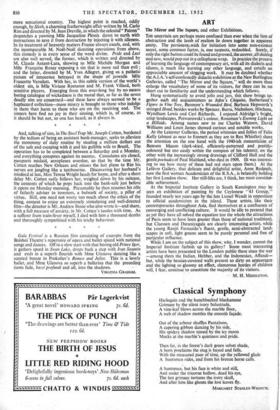ART
The Mirror and The Square; and other Exhibitions.
THE uncertain are perhaps more confused than ever when the lion of abstraction and the lamb of realism lie down together in apparent amity. The persistentovish for 'initiation into some non-existent secret, some common factor, is, one suspects, redoubled. Surely, if only the right button could be found and pressed, the answer, all shining andnew, would pop out in a cellophane wrap. In practice the process of learning the language of contemporary art, with all its dialects and idioms, is much like learning any other language, and entails an appreciable amount of slogging work. It may be doubted whether the A.I.A.'s self-confessedly didactic exhibition at the New Burlington Galleries, called "The Mirror and the Square," will do more than enlarge the vocabulary of some of its visitors, for there can be no short cut to familiarity and the 'understanding which follows.
Hung systematically to avoid jolts and jars, this show brings to- gether such old acquaintances as Jqlm's Chiquita, Sutherland's Figure in Vine Tree, Basmore's Wounded Bird, Barbara Hepworth's stringed Head, besides works by Spencer, Burra, Nicholson, Hitchens, Wyndham Lewis and Ceri Richards. I enjoyed Aldridge's bright, crisp landscapes, Potworowski's colour, Rosoman's Evening Light on a Hillside. Among names new to me Charles Watson, David Williams and Louis James showed curious and notable works.
At the Leicester Galleries, the period whimsies and follies of Felix ICelly (almost as near to Emmett as they are to Rex Whistler) share the attention on the one hand with the 1940-ish romanticism of Bateson Mason (dark-skied, efficiently-patterned and prettily- coloured but too easily within the compass of his talents); on the other with the increasingly strong drawings of Clifford Hall and the gentle pochades of Paul Maitland, who died in 1909. (It was interest- ing to see how many of these had red stars upon them.) At the Lefevre Gallery, that. delicate and delightful artist, Anne Redpath, now the first woman Academician of the R.S.A., is belatedly holding her first London show. Her still-lifes are, I think, her most consider- able achievement.
At the Imperial Institute Gallery in South Kensington may be seen an exhibition of painting by the Ceylonese "43 Group," founded nearly ten years ago by the late Lionel Wendt in opposition to official academicism in the island. These artists, like their contemporaries throughout Asia, find themselves at a confluence of converging and conflicting culture. It would be idle to pretend that as yet they have all solved the equation (on the whole the attractions of Paris seem to have been greater than those of national tradition), but Claessen and Daraniyagala are clearly interesting artists, while the young Ranjit Fernando's fluent, gentle, semi-abstracted land- scapes in soft, light greens seem to be purely personal and free of particular influence. While I am on the subject of this show, why, I wonder, cannot the Imperial Institute furbish up its gallery? Some most interesting artists have been presented to the London public there since the war —among them the Indian, Hebber, and the Indonesian, Affandi- but, while the hessian-covered walls present so dirty an appearance and the lighting so gloomy an effect, clamorous hordes of children will, I fear, continue to constitute the majority of its visitors.
- M. H. MIDDLETON.


































 Previous page
Previous page